How BigCommerce Customers Capitalized on $94 Billion in Online Holiday Revenue


Holiday sales are projected to increase 3.3% across the board this year in the U.S. For online revenue specifically, eMarketer predicts a 17.2% increase from 2015 sales.
That 17.2% increase will account for $94.71 billion in ecommerce revenue, totaling 10.7% of all holiday retail sales. This is the largest portion ever projected for ecommerce as a total of retail spend.

100%
BigCommerce has maintained 100% uptime for 3 consecutive years on the largest online shopping days in history, including Cyber Monday 2016, the biggest online transacting day to-date.
Your brand’s ability to capture a large share of that online revenue should be your number one priority over the next month and a half.
It’s also BigCommerce’s number one priority for you.
Over the last 10 months, our team has worked with one outcome in mind: enabling BigCommerce customers to sell more as effectively and successfully as possible across all channels.
The holiday season is, for us, the culmination of hard work set to motion by customer ingenuity around holiday campaigns and sales.
Indeed, we’ve spent our entire year working to prepare our platform for this moment.
We want you to capture as much as possible of that $94 billion in expected holiday revenue, and we’ve built plenty of integrations we know will help you to do so.
Here is what we released in 2016, why it’s important and how you can implement it on your store right now to increase your revenue this holiday season.
Seamlessly Sell To Over 300 Million Amazon Customers
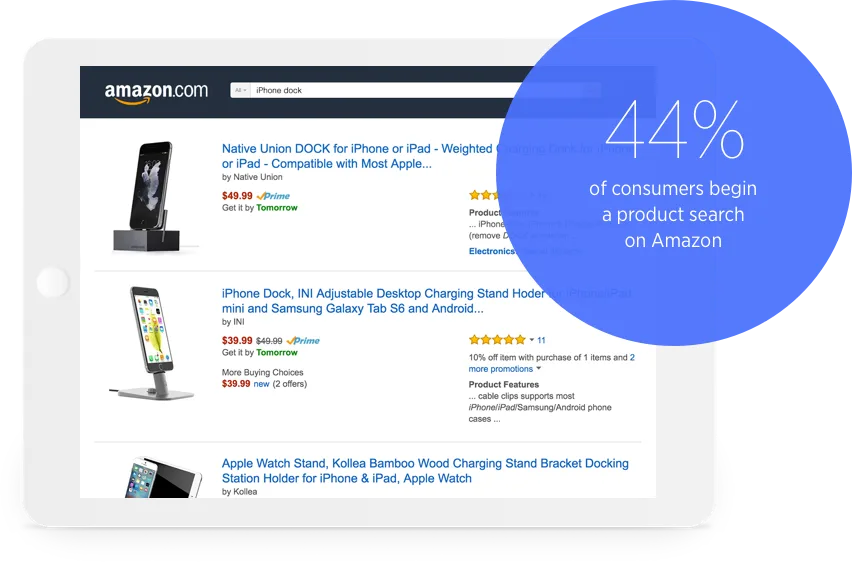
Amazon continues to be powerful driver of ecommerce. Last year, it accounted for over a quarter of online holiday sales, according to NetElixir. It should be even higher this year, as Amazon’s revenue growth continues to outpace ecommerce growth as a whole.
As of 2016, BigCommerce is the only platform to natively integrate with Amazon.
Customers can push inventory directly from their BigCommerce control panel into Amazon’s marketplace, expanding product distribution, visibility and ultimately sales.
For years, our most successful customers have pointed to Amazon as a sales channel for 10x business growth. Those same customers lamented the need to use both the BigCommerce Control Panel and Amazon’s in order to manage inventory, product descriptions, photography and more.
We worked with Amazon for more than a year to integrate the two platforms. Additional partnerships are ongoing for 2017 to continue updating the integration and adding more functionality.
The ultimate goal is to give you a holistic view of all of your sales channels from one vantage point. This is the function of BigCommerce’s Channel Manager, which also integrates with eBay, Facebook and Pinterest.
After utilizing BigCommerce’s marketplace integrations, we have generated an additional $100,000 a month in revenue.
Recommended Posts
Learn how to setup, scale and succeed to more than $1M in sales on Amazon
Get 25 essential selling on Amazon tips and tricks from experts
Sell 43% More By Optimizing for Mobile First
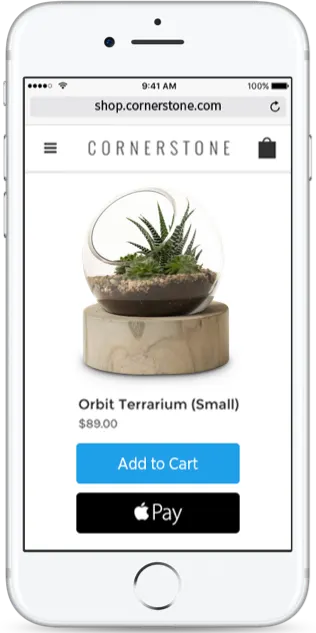
We’re still in the early part of the smartphone commerce revolution, and the development of better app search, payment systems and commerce on new platforms should propel sales strongly in 2017.
Outside of Amazon, the other factor driving increased online sales is mobile. More and more people globally are gaining access to the internet, often through mobile devices. And, mobiles devices are becoming easier and easier to checkout on.
In 2016, data showed that 50% of traffic to a webstore came from mobile, but that 75% of sales occurred on desktop.
We are at the end of the road when it comes to seeing low mobile conversion rates. Mobile commerce isn’t expected to overtake desktop commerce until 2020, but this year, it is expected to see a 43% increase –– totaling $115.92 billion in sales. That translates to 29.1% of retail ecommerce sales and 2.4% of total retail sales for the year.
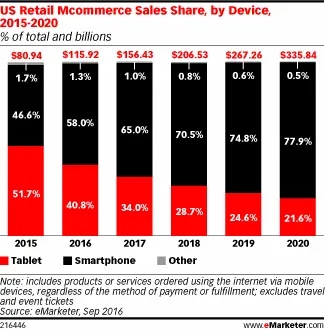
Many online businesses are already preparing for the mobile first era by updating site design and UX to prioritize for mobile. This includes sideswiping, product videos on product pages and mobile wallet checkouts for instance.
In November, BigCommerce launched a new theme and the industry’s first mobile-first template out of the box. The theme is called Touch, and it was designed with celebrity fashion designer LaQuan Smith –– one of the first designers to launch a see now, buy now collection at New York Fashion Week –– and Pixel Union, the industry’s most successful website design agency.
Recommended Posts
Explore and implement the Touch theme now
Seamlessly Sell Existing Inventory to Fans with Facebook Shop
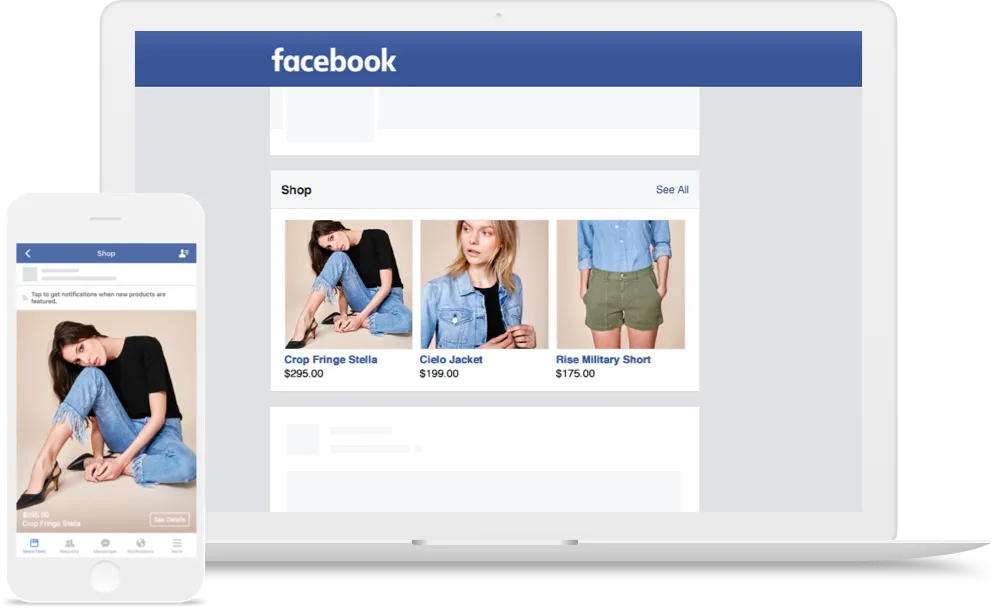
Nearly every platform on the internet where a brand could build an audience is looking to expand into commerce. This includes Facebook, Pinterest, SnapChat and more.
Social commerce was once heralded as the new commerce channel, but few businesses have seen social commerce truly take off.
In 2016, Facebook and BigCommerce decided to tackle that anomaly.
Was it that no one was shopping on Facebook? Or, was it that the analytics weren’t correct? It turns out to have been a combination of both, each giving more weight to the other.
Let’s start with consumers shopping on Facebook.
When Facebook Shop was first launched, brands could add a “Buy” button to their posts and create a separate Shop tab on their business page to feature products. When a customer wanted to check out, they were then forced back to the retailer’s own website. This added an additional step in an already convoluted buyer journey.
Facebook updated this in 2016. Consumers can now checkout without ever having to leave the social media platform –– or at least brands can offer them that option.
But, to the real question, is any of this working?
Are consumers checking out from Facebook as a channel, either on Facebook or back on a retailer’s own website?
The answer is, well, challenging. While Facebook can track conversion son its own platform, it was difficult to get retailers to understand how to track conversions on their own site coming from a Facebook post or ad.
Like Google Analytics, in order to track a Facebook conversion on a website that isn’t Facebook, a pixel must exist.
Unlike with Google Analytics, retailers were not installing the pixel.
Turns out that most ecommerce managers are marketers first and developers second, if at all. Facebook’s manual site pixel placement and developer-friendly language for dropping it in wasn’t resonating.
So, together, BigCommerce and Meta launched a new Meta integration that automatically adds the Facebook pixel to a website. This allows marketers to clearly understand how Facebook ads and Shop are contributing to their bottom line.
And, as it turns out, a lot of brands are seeing the Facebook lift. Here are quotes from just two of them.
Facebook Shop
“We see customers checking out directly on Facebook on a regular basis,” says Krissy Sexton, founder of The Hair Bow Company. “They don’t have to leave Facebook, they can just shop the items that are in the photos. That’s helped increase the effectiveness of our ads. It’s also helped customers be able to easily find exactly what they’re looking for from our ads.”
Facebook Tracking Pixel
Recommended Posts
Integrate with Facebook Shop now and begin tracking conversions
Learn how to start start advertising on Facebook to increase revenue and audience today
3x Sales with Google Shopping and BigCommerce API Partnership

We sought out BigCommerce because of their robust catalog API.
Google Shopping remains one of the most effective ways for online businesses to earn traffic and conversions through advertising. And, the good folks over at Google are continuously working to make the shopping experience for the consumers better –– providing increased success for their advertisers (you!).
Like with the Facebook story, however, success is only achievable in proper measurement and setup. And, like Facebook, the previous way to properly set up Google Shopping tracking and functionality was for a marketer to go to their development team.
This dev step caused 25% of ecommerce marketers trying to setup the integration to just give up.
This was not acceptable for either BigCommerce or Google, and it began a year long project between the two companies. The goal was to configure the first-ever Google Shopping integration with an ecommerce platform that seamlessly pushes data over to Google Shopping in real-time – no development work needed.
Think about this. In the past, ecommerce marketers would have to implement code to set up a data feed to run into Google Shopping. A quarter of them never even passed that first stage. Another portion of them never updated that data feed. This means that inaccurate data was being passed to Google Shopping and used in advertising – likely decreasing ad effectiveness and ROI.
They say you can’t improve what you don’t measure. This was a case of not being able to even properly measure due to an often overlooked step in the process.
So, in 2016, BigCommerce and Google used BigCommerce’s API to resolve both issues, removing two fundamental and time-consuming steps in the Google Shopping process.
Now, stores integrated with Google Shopping can set up ads for their products and know that those products will be updated in Google Shopping anytime they update them on their site.
And, for those brands who have yet to implement Google Shopping, nothing is stopping you. Integrate with the app and you can begin advertising and measuring in no time.
This may sound like house cleaning, but we believe it is essential to optimize processes for functionality before all else.
Google Shopping has tripled our revenue stream bringing in customers we never knew we could market to.
Recommended Posts
Reach 165 Million Buyers Worldwide with eBay
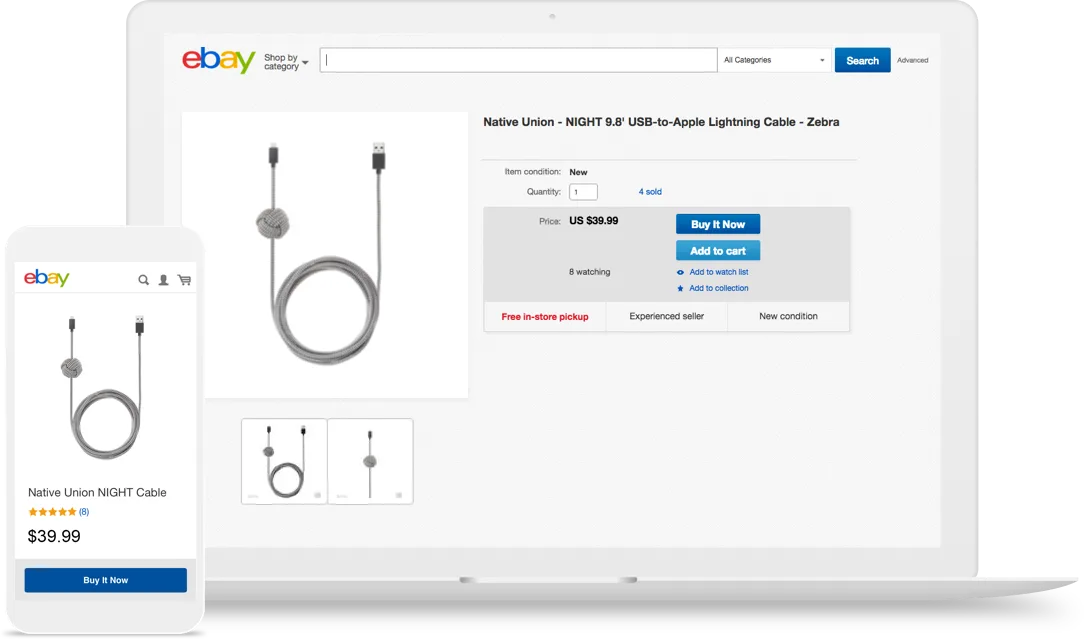
We have taken our business from suspended accounts to more than $100,000 in monthly sales, winning eBay awards for the highest conversion rates.
BigCommerce invested heavily in omni-channel retail in 2016, and eBay was our final push of the year.
eBay’s platform serves 165 million worldwide buyers, making it a great testing ground for U.S. brands thinking about international expansion as well as a great sales channel in general for all online sellers.
Our eBay and Amazon interactions have produced some of the highest revenue for customers since launch. One customer, Wire N Cable, has produced $80,000 in Amazon revenue and a cool $20,000 on eBay.
And Wire N Cable is no outlying case. Other customers including Glory Cycles, Golf Etail and GripUp are seeing similar success –– nabbing spots as top eBay sellers and converters.
The truth of the matter is this: customers will shop anywhere and at anytime. It is getting more and more difficult to predict their purchasing path. To combat this, many brands are expanding into marketplace territory and seeing incredible growth results.
With BigCommerce and eBay’s integration, an ecommerce marketers can push products over to eBay, edit descriptions and set prices all from one interface.
Recommended Posts
Sell to 93% of Pinterest Users Looking to Purchase on Pinterest
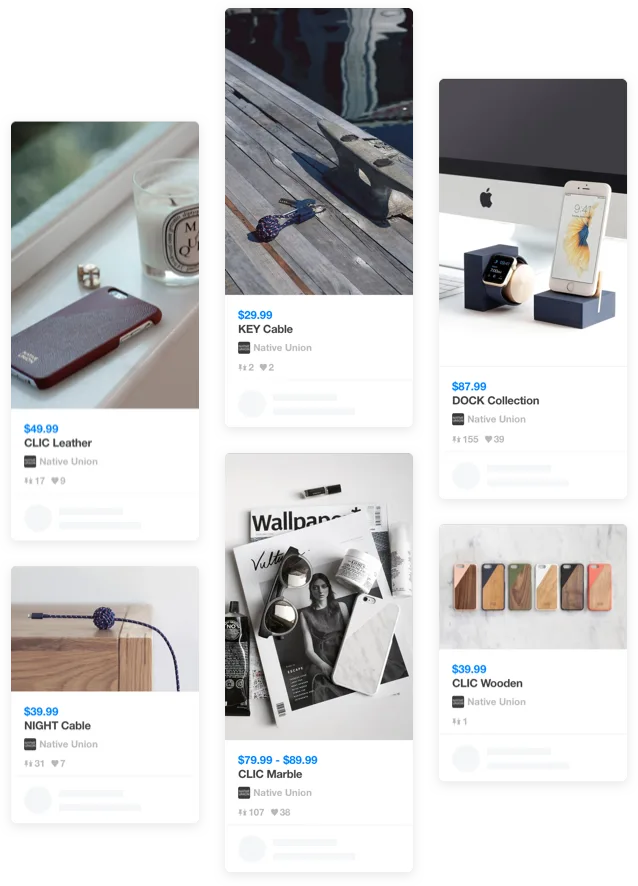
There’s no denying that Pinterest is a high-potential ecommerce channel. With more than 100 million monthly active users, 93% of whom use Pinterest to plan for purchases, Pinterest may be the key for many sellers to unlocking the benefits of social commerce.
Pinterest’s Buy Button launched in 2015, but it has been a slow roll in getting brands involved. This isn’t because of platform limitations on either company’s side. Instead, it is due to Pinterest’s deep desire to make sure that the offering in unparalleled across the social commerce industry.
So far, larger brands like Native Union have seen immense success. Over the course of the next year, it is likely the platform will allow more open integration for brands of all sizes.
One thing we do know is this: selling on Pinterest is working.
And, it’s already integrated in the BigCommerce Channel Manager. Much like with Facebook, Google, Amazon and eBay, BigCommerce merchants accepting by Pinterest to sell on Pinterest can easily push products over through the control panel, getting a holistic view of omni-channel activities.
We will keep you updated to any changes in the Pinterest flow to begin using Buyable Pins. Know, though, that the vast majority of brands getting to sell on the platform are coming through ecommerce platforms like BigCommerce. These are prioritized in their queue and we are continuously working to add functionality to additional stores.
Recommended Posts
Optimize for Omni-Channel Shipping Capabilities
Been using ShipStation for a couple months and it sure has saved time and money. The ability to quickly compare the USPS price to the UPS price has saved me a bunch of money. Not to mention the ability to update my store and marketplaces from one interface has been a time saver!
With all of the focus on omni-channel retail this year, it would have been remiss of us to not also make sure that all of your packages— no matter the channel— can get to the customer as needed.
To do this, we’ve partnered with ShipStation, the leading multi-carrier shipping solution in the industry. We vetted many companies for this position, but found ShipStation to be the clear leader for all BigCommerce merchant sizes, from small business to mid-market enterprise.
Here is why we found ShipStation superior:
The solution is easy to activate and use.
It supports the largest number of domestic shipping carriers.
ShipStation enables BigCommerce customers to receive the lowest possible USPS and Fedex label rates available, and they can easily activate their own account with negotiated rates for a multitude of other shipping carriers, such as UPS and DHL.
BigCommerce merchants should have received a notification in their control panel about the update. But in case you missed it, know this:
All BigCommerce merchants are eligible for a free ShipStation account that includes a USPS postage account with the best rates to save over 50% on USPS Postal Office/USPS.com rates. BigCommerce merchants can continue to use this for free for the first 50 labels/month. This is an exclusive offer Shipstation for BigCommerce customers only. No only solution provides this free of charge.
Here is what you get with your free account:
Print Shipping Labels and Packing Slips in Batch: With ShipStation, you can process and print hundreds of labels in a single batch. Print pick lists, packing slips, and labels easily and quickly to either your local printer or any printer in the world! No more manual data entry for you.
Unlimited Selling Channels: We want to make you efficient at fulfilling orders, wherever you sell online. That’s why no matter which pricing plan you’re on, you can add as many selling channels as you want. Selling on Amazon, Etsy, eBay, and more? Add all your accounts to ShipStation to easily sync orders and shipping data. For no extra charge.
Shipping Carriers: ShipStation supports USPS, UPS, FedEx, DHL, Canada Post, and more. There’s no need for add-on tools such as UPS WorldShip. ShipStation also allows you to retrieve real-time rates and take advantage of the best prices from each carrier.
No Software to Install: ShipStation is a web-based solution that is hosted in the cloud. This means that you never have to worry about installing software, upgrading, or backing up your data. Simply log into your account from any web browser to manage your orders, create shipping labels, and view reports.
Recommended Posts
BigCommerce is Officially on Code Freeze
Each year, BigCommerce enters code freeze before the official start of the holidays. Doing so has helped us achieve 100% uptime over the last three holiday seasons, including on Black Friday –– the two highest trafficked online shopping days in history.
A code freeze is a development term which means that no code can be edited or modified during the freeze period. It’s done to ensure steady uptime and site speed during high traffic periods, rather than releasing new code.
For BigCommerce, a code freeze means we stop making changes, integrations or updates to the platform during our customer’s highest traffic periods. This ensures that your customers have a frictionless shopping experience — which is always our top priority.
Essentially, we are getting out of your way so you can be as successful as possible during the most trafficked shopping season of the year.
As of today, we are officially on code freeze for the remainder of 2016.
Our product team is heads down on 2017 planning, with hands off the product until that time.
Our support and education teams are focused on helping our customers get the most out of the BigCommerce platform. They are working around the clock to answer any questions you may have. You can chat them here, call 1-888-699-8911 or email support@bigcommerce.com.
Our marketing and sales teams are slowing down communications, reducing emails to the bare essentials so you can focus on your sales without missing a thing.
Our year has officially wound down. But for most of our customers, it is just about to take off.
Happy Selling Season!
We hope you are prepared. We hope you’ve used every possible outlet to increase sales, brand visibility and set yourself up for success.
We’ll be here on phone lines if you need help.
In the meantime, know that we are dedicated to your technical success this holiday season.
We’ll be back at it in 2017 to continue iterating on our product and making partnerships with best-in-class companies to make you a more successful online seller.
Recommended Posts

BigCommerce is a leading ecommerce platform that empowers businesses to grow with flexibility and scalability. We are dedicated to helping our customers expand their businesses and improve their bottom line. Through thought leadership on ecommerce trends, best practices, and innovations, we provide in-depth insights into both B2C and B2B strategies, enabling businesses to succeed and thrive in today’s dynamic digital marketplace.


